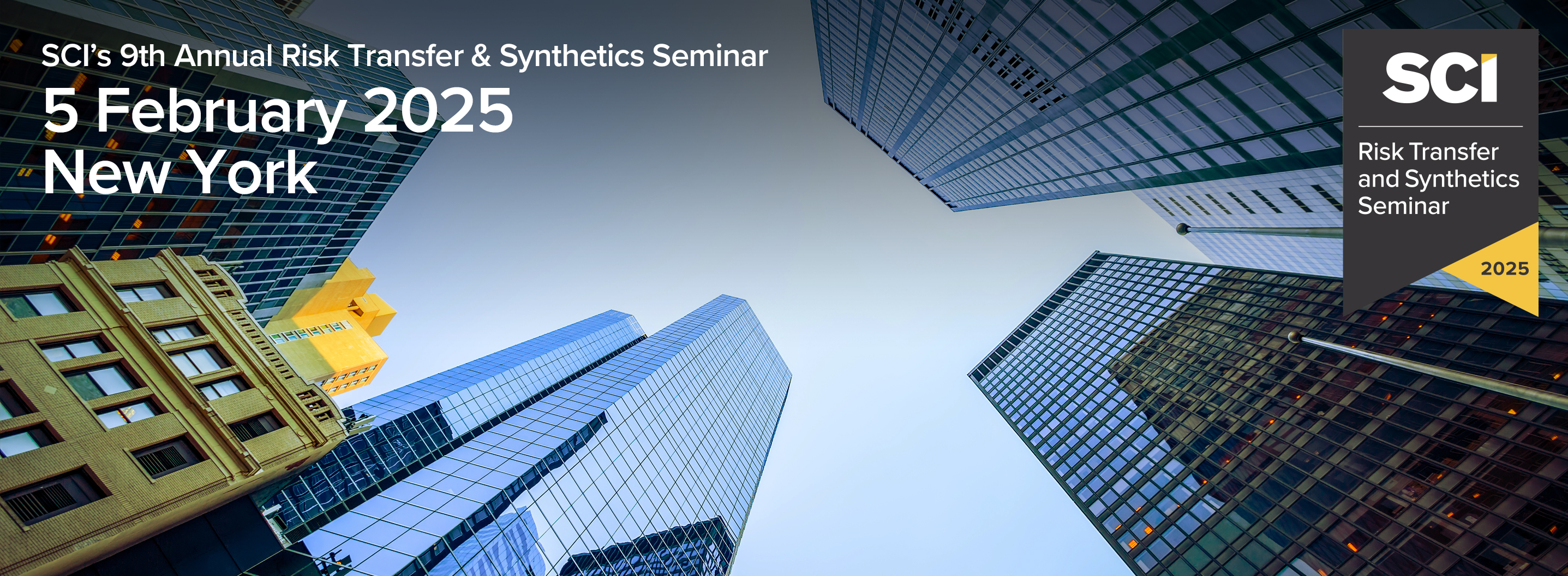JOIN SCI FOR THE 9TH ANNUAL RISK TRANSFER AND SYNTHETICS SEMINAR
Exclusive Host

Platinum Sponsor

Gold Sponsor

Silver Sponsor





Exhibitor Sponsor

Draft Agenda
-
-
8:00 AM - 9:00 AMRegistration & Networking Breakfast
-
- New administration in the White House and Congress. Possibility of B3E slipping off the agenda and its impact on CRT issuance in the U.S.
- Key agency appointments affecting CRT industry; potential replacements and their influence
- Possible shift in the U.S. regulatory regime towards the lighter approach seen in the EU
- Regulatory impact on deal structuring, especially under Reg
- Potential rollback of existing regulations and its significance for the industry
Panel Includes:
Christopher Horn, Cadwalader (Moderator)
Mark Kruzel, PIMCO
Joseph Hwang, Goldman Sachs
Tom Killian, TWK Advisors
Tom O'Hara, Bayview Asset Management
-
10:30 AM - 10:50 AMNetworking Break
-
- How will the incoming administration affect the GSEs? Will the conservatorship debate be revived?
- Now that the GSE programs CAS/STACR are firmly IG, has the investor base changed, and will it change further?
- What will issuance look like in 2025?
- What will be the mix between capital markets and reinsurance? What is the capacity of both, and is it expected to change? What is the relative value trade in 2025?
- Recent structural nuances.
Panel Includes:
Lima Ekram, RenaissanceRe (Moderator)
Ani Gelashvili, J.P. Morgan
Michael Shemi, Guy Carpenter
Mark Fontanilla, Mark Fontanilla & Co.
Charlotte Gladwin, Freddie Mac
-
- Deal structure considerations under Reg Q
- Core components of synthetic securitization; considerations related to Volcker and CFTC regulations
- Comparing syndicated deals versus bilaterally negotiated ones; examining if a middle ground exists. What are the benefits and disadvantages of different types of syndication. Is there one option that is better than the rest and why?
- What are the benefits and disadvantages of different types of syndication. Is there one option that is better than the rest and why?
- US banks continue to be uncomfortable issuing syndicated deals using SPVs, despite consensus among external counsel that it is possible. Is this impeding the development of the market?
- Considerations related to Volcker and CFTC regulations
- Possibility of reinsurers becoming eligible guarantors; alternative of writing guarantees from a European subsidiary
Panel Includes:
Julie Gillespie, Mayer Brown (Moderator)
Ivan Loncar, Cadwalader
Melissa Ferraro, Linklaters
Gareth Old, Clifford Chance
-
12:30 PM - 1:30 PMLunch & Networking Break
-
- Difference of motivation between regionals and G-SIBs
- Difference of investors in deals issued by larger banks and smaller banks
- Difference of regulatory approach to the regionals
- What are the obstacles for regionals? Cost, expertise, operations, resources, governance?
- Will regionals reference different assets? What about CRE?
- Will new types of investors come to the market in 2025?
Panel Includes:
Daniel Esposito, RBC Capital Markets (Moderator)
Sandro Kraft, Valley Bank
Brian Gilbert, Pinnacle Financial Partners
Eric Bisman, Ally Financial
Chip Salter, Wells Fargo Securities
-
- Assets gaining popularity with CRT issuers and reasons behind their appeal
- Potential for new asset classes in 2025 and market need for diversification to boost yields
- Adjusted expectations for the U.S. market following 2024’s underperformance
- Investor opportunities in portfolio construction and specific assets
- Potential growth in riskier assets, exemplified by a recent hospital loan CRT with 13% yields
Panel Includes:
Jed Miller, Cadwalader (Moderator)
Frank Benhamou, Cheyne Capital
Charles Martino, JPMorgan Securities
Sagi Tamir, Mayer Brown
Rob Lewin, Tokio Marine HCC - Guaranty Group
-
3:10 PM - 3:30 PMNetworking Break
-
- Narrowing CRT spreads; comparison with other assets, particularly CLOs
- CRT’s competitive standing in broader market pricing
- Possible shift of new buyers away from CRT to other asset classes
- Fairness of a focus on spread compression; unique asset exposures in CRT market
- CLO yields compared to CRTs, and evaluating if this comparison is appropriate
- Weighing dedicated SRT strategies against hybrid strategies
Panel Includes:
Logan Piper, Credit Benchmark (Moderator)
Jason Marlow, Barclays
Kaelyn Abrell, ArrowMark Partners
Sara McGinty, Ares Credit Group
Karan Chabba, Eagle Point Credit Management
-
- Comparison of U.S. and European CRT markets, with Europe as an established, robust market
- Insights U.S. market might gain from European experience
- Structural differences in the markets; investor base and trade structures across regions
- What are the benefits of completing an SRT as an issuer in Europe? How is this different in the US?
Panel Includes:
Leanne Banfield, Linklaters (Moderator)
Terry Lanson, Seer Capital
Jennifer Bearden, IACPM
Juan Grana, Chorus Capital; Co.
Jessica Littlewood, Clifford Chance
Silvia L. Ramirez, IMF
-
5:10 PM - 6:10 PMCocktail Reception
-











































































